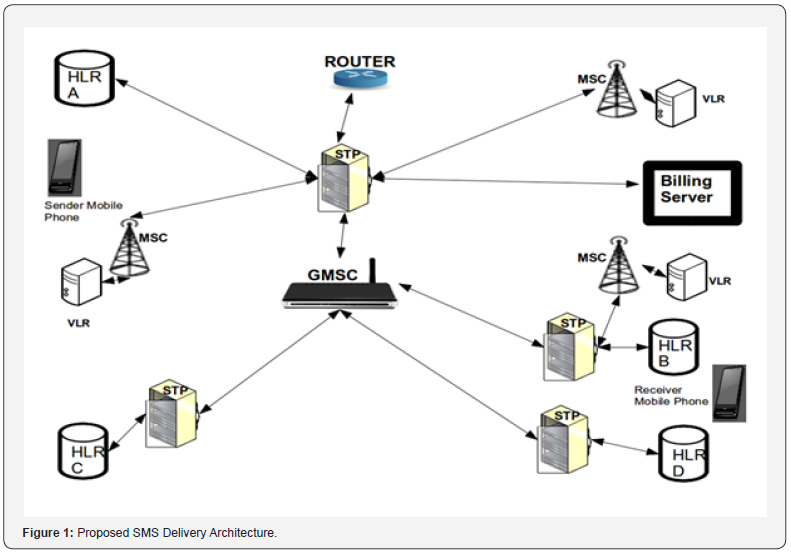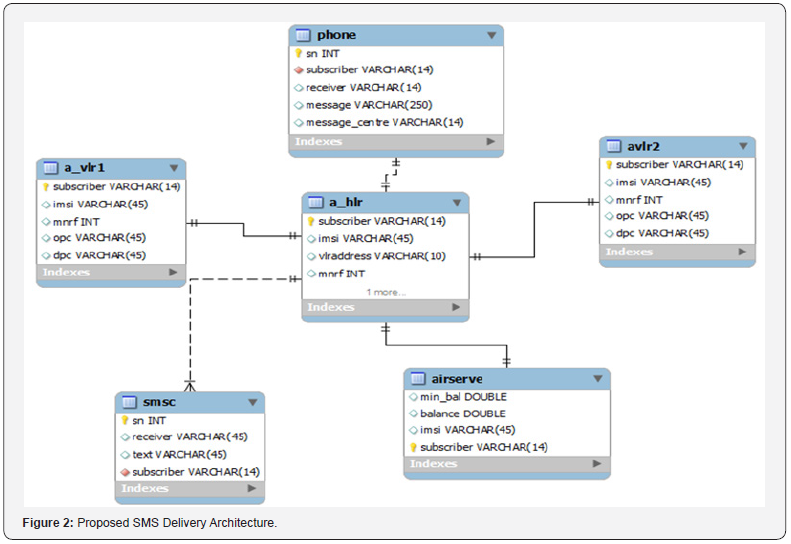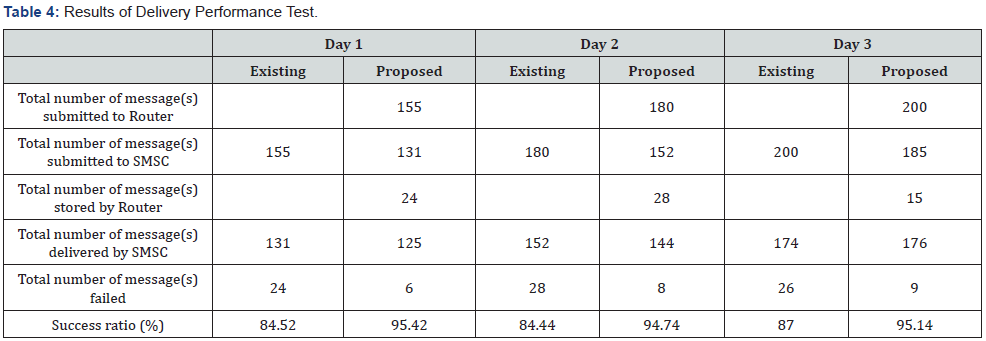Route Optimization and Delivery of Short Message Service in Telecommunication Networks
O Osunade* and SO Nurudeen
Department of Computer Science, University of Ibadan, Ibadan, Nigeria
Submission: January 31, 2023; Published: February 22, 2023
*Corresponding author: O Osunade, Department of Computer Science, University of Ibadan, Ibadan, Nigeria
How to cite this article: O Osunade and SO Nurudeen. Route Optimization and Delivery of Short Message Service in Telecommunication Networks. Trends Tech Sci Res. 2023; 6(1): 555678. DOI: 10.19080/TTSR.2023.06.555678
Abstract
There are over 20 million subscribers to telecommunication services in Nigeria. The telecommunication services have impacted the frequency and mode of communication of users. The Short Message Service (SMS) is one of the widely used services by subscribers due to the ability for recipients to read messages at their convenience. SMS uses computing devices such as routers and servers for delivery of messages to subscribers on a network. Not all messages sent by subscribers are delivered. An evaluation of the log files for SMS delivery indicated a high failure rate due to Absent Subscriber. This work aims to propose a solution to reduce the incidence of Absent Subscriber error. The proposed solution prevents the direct submission of the message for delivery. The proposed model was simulated using Java. The results indicate a reduction in failure rate of messages sent by subscribers.
Keywords: Short Message Service (SMS); Mobile Phone; Delivery Error; Routing Success Ratio
Abbreviations: SMS: Short Message Service; SMSC: Short Message Service Centre; ITU: International Telecommunication Unit; MT: Mobile Termination; MNRF: Mobile Number Reachable Flag Status; VLR: Visitor Location Register; HLR: Home Location Register; GMSC: Gateway Mobile Switching Centre; MSC: Mobile Switching Centre; VMSC: Visitor Mobile Switching Centre; MS: Mobile Station; CRD: Call Detail Records; SR: Success Ratio
Introduction
The Short Message Service Centre (SMSC) is responsible for the routing and delivery of Short Message Service (SMS). When a SMS message is delivered to the SMSC, a store-and-forward message mechanism is implemented, whereby the message is temporarily stored, then forwarded to the recipient’s phone when the recipient device is available. A SMS message may pass through a number of SMSC or other SMS gateways, which act as bridges between two or more SMSCs’ running different SMSC protocols, before reaching the recipient’s device. An SMSC helps route SMS messages and manage the process. If the intended SMS recipient is not active, the SMSC will keep the stored SMS message for a “validity period” before deleting it from storage. Message failure ratio, defined as the percentage of messages that fail to reach their receiver, is expected to be close to zero. However, investigation shows that the above assumption does not hold in reality.
According to International Telecommunication Unit (ITU) the total number of SMS sent worldwide had tripled between 2007 and 2010, meaning that roughly 200 thousand messages are sent every second on mobile devices. One of the reasons for such tremendous growth of SMS traffic is due to rapid fall in the price of mobile phone and cost of sending SMS. However, due to lack of maintenance and other reason such as power failure on the mo bile device large proportion of messages sent were not delivered because the recipient of the message was not reachable. This kind of error is known as “Absent Subscriber” error for Mobile Termination (MT), thus affecting the performance of SMSC, though there are other errors affecting its performance. For every failed message due to absent subscriber the SMSC has to do a number of retries based on the retry policy implemented for a valid period of time, after this period the message will be discarded if the recipient is not reachable. This is seen as an inefficient way of utilizing SMSC resources. In order to increase the performance and efficiency of SMSC, this work focuses on how to reduce the number of absent subscriber error on SMSC thus reducing the number of retries [1].
A survey on the SMS service in a real operational GSM network was carried out to obtain a baseline for efficient delivery of SMS in terms of message success/failure ratio, errors affecting the performance of SMSC and latency. The survey identified Absent Subscriber error as a major error affecting the performance of SMSC thus affecting SMS delivery. The aim of this work is to optimize the existing SMS delivery mechanism so as to reduce the amount of absent subscriber error in the SMSC. The objectives of this work are to propose and test a solution that achieves the best balance between subscriber service quality and network loading.
Literature Review
Proposed SMSC Architecture
In this work the existing SMS delivery architecture is modified with the addition of a Router. The Router holds the transmitted message, checks the subscriber status from HLR/VLR, sends the message to the SMSC when the subscriber is available and holds the message for a period if the subscriber is not available. The proposed SMS delivery architecture is shown in Figure 1 below. Due to restriction arising in implementing this solution in a real live scenario, our work is based on software, each of the network element, Phone, SMSC, STP, MSC, Router, HLR, VLR and GMSC in our architecture were modeled as a software component and made to exchange information between each other as in real life scenario [2].

The software component phone will have an interface that accept user input, this will allow the user to compose his/her message and send, after the initial text input the system will automatically pick different sender and receiver from the database and send. The loop will continue for a specified number of times. The parameter that is needed for sending message in a real-life scenario is also needed in our modeling which include:
• Originating address (sender MSISDN)
• Destination address (recipient MSISDN)
• SMSC GT
• Text message
The traffic pattern and flow in our model is also similar to that of real-life scenario. As the MO traffic arrives at the MSC they are placed on STP for routing and global title translation, based on MAP screening implemented on STP all the MO traffic towards STP are re-routed to SMS router, for each of the message received router will check availability of the recipient by sending check flag request to HLR if the response is 1 then the recipient is active and the message will pass on to the SMSC, otherwise the router will keep the message and retry for a valid period of time based on the retry policy configured, if the validity period expires and the subscriber is not still reachable the message will be discarded.
For SMSC to accept the MO message it must check whether the sender has enough credit to send SMS, it does this by sending a balance request query to Air server, if the message originator has enough credit to send text it then set the minimum balance of the subscriber to the cost of sending a text message e.g. N5, N10, N15 etc. based on subscriber service class and then accept the MO message, otherwise it reject the SMS. For every MO message submitted to SMSC, SMSC will increment total number of messages submitted and assign a unique id for that transaction, this will allow the system to distinguish between two or more messages that arrives at SMSC at the same time from the same sender and to the same recipient [3].
SMSC we then try to deliver the message to the recipient after getting the serving MSC of the recipient, MSC will query VLR for recipient mobile number reachable flag status (MNRF) and return the status to SMSC, if the status is 1 then SMSC do the following
i. increment total message delivered.
ii. charge the sender.
iii. Set the minimum balance back to Zero.
Otherwise, if the status is Zero then the total error will be incremented and SMSC will keep the message in its database and do a retry based on the retry policy configured for a valid period of time.
Methodology
This work used simulation to test the performance of the proposed SMS delivery architecture and compare with the existing SMS delivery method. The two SMS delivery methods were simulated using 155 messages for delivery to subscribers within four mobile telecommunication networks. The structure In Figure 2 below represents the schema for the primary network operator we have used in this work, the work considered transaction between four network operator, each operator has two Visitor Location Register (VLR) and one Home Location Register (HLR). Network operator ‘A’ is considered as the primary network and is the only network that has Short Message Service Centre (SMSC). Messages (SMS) to other network are routed from SMSC to Gateway Mobile Switching Centre (GMSC). Gateway MSC is a function of Mobile Switching Centre (MSC) capable of receiving a message from an SMSC, interrogating an HLR for routing information and SMS information, and delivering the message to the Visitor Mobile Switching Centre (VMSC) of the recipient mobile station (MS) [4].

In this work all the network elements needed for sending SMS are represented as a software component. Four databases were also created (one for each network operator) to store the information that is needed on each of the network element. For the purpose of simulation and to avoid delay in composing SMS, the software component phone’s table in the database is preloaded with SMS to be sent; once the send button on the user interface is clicked the SMS transaction begins and run to completion. On completion the call detail records (CDR), or logs will be generated which was collected for analysis.
The performance was calculated using the following equations:
Success ratio (SR) is measured as follows:
SR = SD/TS* 100 …...................... Eq 1
and
SD = TS – E .......................... Eq 2
where,
Total number of messages submitted to SMSC = TS
Total number of messages successfully delivered = SD
Total number of messages failed = E
Results And Discussion
Five (5) tests were performed on the existing and proposed SMS delivery architecture. The tests are mobile originated message submission; send routine information, mobile terminated, delivery performance and delivery time. The results are presented and discussed below:
Mobile Originated Message Submission Test
The results in Table 1 indicate that there is communication between the mobile phone, Mobile Switching Center (MSC), Router and Short Message Service Center (SMSC). The proposed SMS delivery architecture detects delivery errors when sending messages to the Short Message Service Center (SMSC). The existing SMS delivery architecture does not detect errors during this test.

Send Routine Information Test
When the two SMS delivery architecture sent requests to determine the location of the subscriber from the HLR, the right location was returned. Table 2 shows that both architecture work.

Mobile Terminated Test
At the delivery point when subscribers are expected to receive messages, Table 3 indicates that both SMS delivery architectures had positive and negative delivery reports. This confirms the presence of Absent Subscriber error in both architectures. The difference in frequency will be shown by the delivery performance test carried out next.

Delivery Performance Test
Table 4 shows the simulated results for 3 days when 155, 180 and 200 messages are sent on the network. The success ratio indicates that the proposed SMS delivery architecture had better performance each time. The performance difference is indicated by the “Total number of message(s) failed.” The number of failed messages for the proposed SMS delivery architecture is less than that of the existing architecture because of the work done by the introduced router. The possible delivery errors detected by the Router reduce billing for services not rendered and allow the message senders to re-transmit their messages at other times.

Delivery Time Test
The result of the average mean time for 155 messages submitted directly to SMSC and via Router, and the time it was submitted to the mobile device (latency), is presented in the Table 5 above. The proposed SMS delivery architecture takes more time to perform the same task as the existing SMS delivery architecture. The time difference is however small, and the subscriber is not likely to notice [5].

Conclusion
The results prove that SMS delivery is better when the availability of the recipients of messages are first checked by the newly introduced SMS router before the traffic is forwarded to SMSC for processing and delivery. As applications based on bulk messaging become increasingly popular, bulk messages that are delivered mostly from content providers to large groups of mobile users have the possibility of increased Absent Subscriber error on the telecommunication network. The proposed SMS delivery solution can also serve as a measure to protect the networks from congestion that might occur due to bulk messages. With the addition of a new network element in the proposed solution, the result shows that, the latency introduced is a few milliseconds which is insignificant as the subscriber will not notice any substantial delay.
Acknowledgment
The authors appreciate Mr. OD Adeniji for his comments, advice and contribution to this work.
References
- Dryburgh L, Hewett J (2003) Signaling System No. 7 (SS7/C7): Protocol, Architecture, and Applications, Published by Cisco Press, USA.
- Intel Corporation (2003) SMS messaging in SS7 networks: optimizing revenue with modular components, Intel in Communications, USA.
- Naor Z (2004) An efficient short messages transmission in cellular networks, Proceedings of 23rd Annual IEEE Conference on Computer Communications (INFOCOM), Hong Kong.
- Xiaoqiao M, Zerfos P, Samanta V, Wong SHY, Songwu Lu (2007) Analysis of the Reliability of a Nationwide Short Message Service. In INFOCOM 2007. 26th IEEE International Conference on Computer Communications. IEEE pp. 1811-1819.
- Zerfos P, Meng X, Samanta V, Lu S (2006) A Study of the Short Message Service of a Nationwide Cellular Carrier, Proceedings of ACM SIGCOMM Internet Measurement Conference (IMC), Rio de Janeiro, Brazil.






























